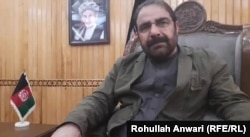Clashes between the Islamic State militants (IS) and the Taliban have forced tens of thousands of civilians to flee their homes in two provinces in eastern Afghanistan.
Saida Gul is among the most recent victims of largely underreported fighting between the two militant groups in the remote forested valleys of Nangarhar and Kunar provinces.
Gul was one of the more than 50,000 civilians -- according to UN estimates -- who were forced to leave their homes after clashes erupted in Nangarhar’s Khogyani and Sherzad districts last month.
He says their escape from the sudden onset of fighting was dramatic. “Someone’s child disappeared, and someone’s mother is still missing,” he told Radio Free Afghanistan from his temporary shelter in Jalalabad, the capital of Nangarhar. “People left all their belongings at home and only rescued themselves.”
Ataullah Khogyani, Nangarhar’s provincial governor’s spokesman, says nearly 1,500 families have been displaced. But a May 2 report by the United Nations Office for the Coordination of Humanitarian Affairs estimates more than 56,000 civilians comprising 8,047 families have fled the two districts.
In neighboring Kunar, the displacement began in March, and many civilians have received little or no assistance. Ahmadullah Dilsoz is among the thousands who fled their homes in a remote Kunar valley after IS and the Taliban began battling one another.
Dilsoz, 20, is an 11th-grade high-school student. His family of 12 left behind everything they owned: their house, their fruit orchard, and the small field they farmed for a living. His village, Serai, is one of scores of impoverished hamlets in the picturesque alpine valley of Kunar’s Chapa Dara district, where most residents have fled.
“We fled because of the fighting between the Taliban and Daesh,” he told Radio Free Afghanistan while referring to IS by its Arabic acronym. “Daesh militants were shooting everyone. They attacked the Taliban and ordinary people's homes. Everyone was afraid.”
He says the sight of masked IS fighters struck terror into the hearts of residents because the ultra-radical group wants to impose strict rules on the conservative region.
Dilsoz’s father died two years ago, and he is now the family’s breadwinner. They rent a shabby house in the provincial capital, Asadabad, for the equivalent of $30 in Pakistani rupees. The rupee is used as the local currency in parts of Afghanistan’s long border with Pakistan.
He says his daily wage of nearly $2 is not enough to make ends meet. “People have a lot of problems,” he said. “They need everything, such as shelter and fans, because it’s hot here. We have only received some food staples [in aid].”
Dilsoz’s mother, Shabnam, who goes by one name only, says the local government should help them.
“It’s getting hot here, and it’s the month of Ramadan,” she said of their misery in the Islamic holy month, when Muslim adults are expected to abstain from food and drink from dawn till dusk. “There is nothing.”
Local officials say more than 3,000 families were forced to leave Chapa Dara district. Kunar Governor Abdul Satar Mirzakwal maintains that they have provided displaced civilians with essential aid such as food staples and money.
He says their intelligence indicates that 400 IS fighters are active in Kunar’s Chapa Dara, Manogai, and Sawkai districts. Despite robust propaganda efforts, he says, IS militants have failed to attract locals to their cause.
“They ruin shrines and mosques and don’t respect the elderly,” he told Radio Free Afghanistan. “They shut down schools. The people of Kunar don’t approve of such actions.”
Mirzakwal says IS has failed to connect Kunar to northeastern Badakhshan Province through a corridor of territory they control.
IS officially announced its emergence in Afghanistan and Pakistan with the formation of its Khorasan Province branch in early 2015. The group soon swept several Nangarhar districts bordering Pakistan.
U.S. and NATO military operations have apparently failed to wipe IS out of its eastern Afghanistan strongholds. The group still poses a serious security challenge for Kabul and its international backers.
Nicholas Kay, NATO’s senior civilian representative in Afghanistan, told Radio Free Afghanistan in April that the threat of IS-linked militants in the country should be taken seriously.
“Their presence, at the moment, is limited to parts of [small] geographic areas,” he said. “But they are persistent, and they are responsible for some atrocious high-profile terrorist attacks against civilian targets in Kabul and elsewhere.”
Afghan officials continue to claim progress against the group. Mirzakwal says some displaced families have returned to Chapa Dara after Afghan security forces pushed the militants into neighboring Laghman Province.
But for Dilsoz in Asadabad, little has changed. Besides worrying about his family’s security and livelihood, he is saddened that the displacement deprives his siblings of their education.
“I'm worried that they cannot attend school and their fate is still uncertain,” he said.






